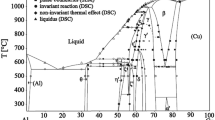Abstract
Phase equilibrium in the CeBr3–CsBr binary system was established from differential scanning calorimetry (DSC). This system includes three compounds, namely Cs3CeBr6, Cs2CeBr5 and CsCe2Br7; and three eutectics located at CeBr3 molar fraction x = 0.125; 0.459 and 0.700, respectively. Cs3CeBr6 undergoes a solid–solid phase transition at 712 K and melts congruently at 1034 K. Cs2CeBr5 decomposes in the solid state into Cs3CeBr6 and CsCe2Br7 at 685 K. The third compound, CsCe2Br7, melts congruently at 877 K. The electrical conductivity of CeBr3–CsBr liquid mixtures was measured down to temperatures below solidification over the whole composition range. Results obtained are discussed in term of possible complex formation.





Similar content being viewed by others
References
Seifert HJ. Ternary chlorides of the trivalent early lanthanides. Phase diagrams, crystal structures and thermodynamic properties. J Therm Anal Cal 2002;67:789–826.
Rycerz L. High temperature characterization of LnX3 and LnX3-AX solid and liquid systems (Ln = Lanthanide, A = Alkali, X = Halide): thermodynamics and electrical conductivity. Ph. D. Thesis, Marseille; 2003.
Rycerz L. Thermochemistry of lanthanide halides and compounds formed in lanthanide halide-alkali metal halide systems (in Polish). Scientific Papers of Institute of Inorganic Chemistry and Metallurgy of Rare Elements, Wroclaw University of Technology, Series Monographs 35, Wroclaw; 2004.
Ingier-Stocka E, Rycerz L, Gadzuric S, Gaune-Escard M. Thermal and conductometric studies of the CeBr3-MBr binary systems (M = Li, Na). J Alloys Comp 2008;450:162–6.
Rycerz L, Ingier-Stocka E, Gadzuric S, Gaune-Escard M. Phase diagram and electrical conductivity of CeBr3-KBr. Z Naturforsch 2007;62a:197–204.
Rycerz L, Ingier-Stocka E, Gadzuric S, Gaune-Escard M. Phase diagram and electrical conductivity of the CeBr3-RbBr binary system. J Alloys Comp 2008;450:175–180.
Fouque Y, Gaune-Escard M, Szczepaniak W, Bogacz A. Syntheses, measures des conductibilites electriques et des entropies de changements d’etat pour le compose Na2UBr6. J Chim Phys 1978;75:361–6.
Janz GI. Thermodynamic and transport properties for molten salts; correlation equations for critically evaluated density, surface tension, electrical conductance, and viscosity data. J Phys Chem Ref Data. 1988;17 Suppl 2:232
Seifert HJ. Ternary chlorides of the trivalent late lanthanides. J Therm Anal Cal 2006;83:479–505.
Potapov A, Gaune-Escard M. Deviations from the Arrhenius equation of electrical conductivity polytherms. In: Øye HA, Jagtøyen A, editors. Proccedings of the International Symposium on ionic liquids in honour of Professor Marcelle Gaune-Escard. Carry le Rouet, France; 2003, June 26–28. pp. 477–81.
Gadzuric S, Ingier-Stocka E, Rycerz L, Gaune-Escard M. Electrical conductivity of molten binary NdBr3-alkali bromide mixtures. Z Naturforsch 2004;59a:77–83.
Ziolek B, Rycerz L, Gadzuric S, Ingier-Stocka E, Gaune-Escard M. Electrical conductivity of molten LaBr3–MBr binary mixtures. Z Naturforsch 2005;60:75–80.
Van Artsdalen ER, Yaffe JS. Electrical conductance and density of molten salt systems: KCl-LiCl, KCl-NaCl and KCl-KI. J Phys Chem 1955;59:118–27.
Yaffe JS, van Artsdalen ER. Electrical conductance and density of pure molten alkali halides. J Phys Chem 1956;60:1125–31.
Photiadis GM, Borresen B, Papatheodorou GN. Vibrational modes and structures of lanthanide halide–alkali halide binary melts; LnBr3-KBr (Ln = La, Nd, Gd) and NdCl3-ACl (A = Li, Na, K, Cs). J Chem Soc Faraday Trans 1998;17:2605–13.
Rycerz L, Gaune-Escard M. Unpublished results.
Acknowledgements
Financial support by the Polish Ministry of Science and Higher Education from budget on science in 2007–2010 under the grant N–N204 4098 33 is gratefully acknowledged. L.R. and E.I.-S. wish to thank the Ecole Polytechnique de Marseille for hospitality and support during this work.
Author information
Authors and Affiliations
Corresponding author
Electronic supplementary material
Below is the link to the electronic supplementary material.
Rights and permissions
About this article
Cite this article
Rycerz, L., Ingier-Stocka, E. & Gaune-Escard, M. Phase diagram and electrical conductivity of the CeBr3–CsBr binary system. J Therm Anal Calorim 97, 1015–1021 (2009). https://doi.org/10.1007/s10973-009-0007-6
Received:
Accepted:
Published:
Issue Date:
DOI: https://doi.org/10.1007/s10973-009-0007-6




